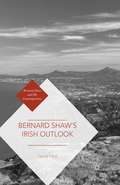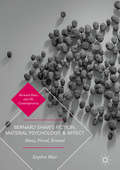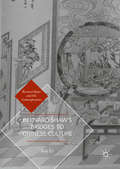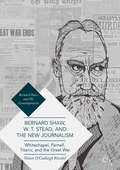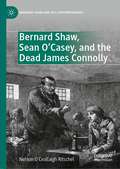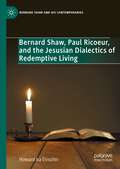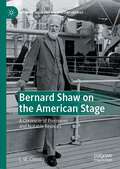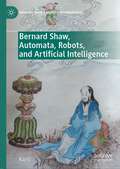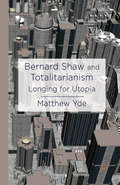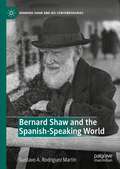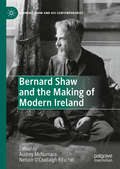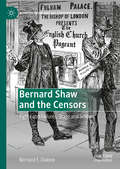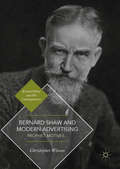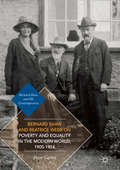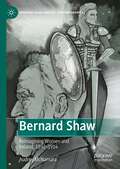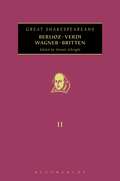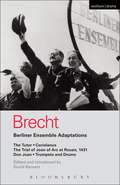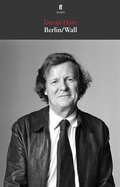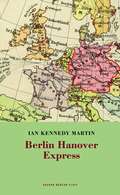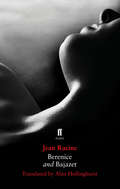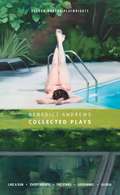- Table View
- List View
Bernard Shaw’s Irish Outlook (Bernard Shaw and His Contemporaries)
by David ClareUsing close readings of Shaw's plays and letters, as well as archival research, David Clare illustrates that Shaw regularly placed Irish, Irish Diasporic, and surrogate Irish characters into his plays in order to comment on Anglo-Irish relations and to explore the nature of Irishness.
Bernard Shaw’s Fiction, Material Psychology, and Affect: Shaw, Freud, Simmel (Bernard Shaw And His Contemporaries Ser.)
by Stephen WattThis book traces the effects of materiality - including money and its opposite, poverty - on the psychical lives of George Bernard Shaw and his characters. While this study focuses on the protagonists of the five novels Shaw wrote in the late 1870s and early 1880s, it also explores how materialism, feeling, and emotion are linked throughout his entire canon. At the same time, it demonstrates how Shaw's conceptions of human subjectivity parallel those of two of his contemporaries, Sigmund Freud and Georg Simmel. In particular, this book explores how theories of so-called 'marginal economics' influence fin de siècle thought about human psychology and the sociology of the modern metropolis, particularly London.
Bernard Shaw’s Bridges to Chinese Culture (Bernard Shaw and His Contemporaries)
by Kay LiThis book explores the cultural bridges connecting George Bernard Shaw and his contemporaries, such as Charles Dickens and Arthur Miller, to China. Analyzing readings, adaptations, and connections of Shaw in China through the lens of Chinese culture, Li details the negotiations between the focused and culturally specific standpoints of eastern and western culture while also investigating the simultaneously diffused, multi-focal, and comprehensive perspectives that create strategic moments that favor cross-cultural readings.With sources ranging from Shaw's connections with his contemporaries in China to contemporary Chinese films and interpretations of Shaw in the digital space, Li relates the global impact of not only what Chinese lenses can reveal about Shaw's world, but how intercultural and interdisciplinary readings can shed new light on familiar and obscure works alike.
Bernard Shaw, W. T. Stead, and the New Journalism: Whitechapel, Parnell, Titanic, and the Great War
by Nelson O'Ceallaigh RitschelThis book explores Bernard Shaw’s journalism from the mid-1880s through the Great War—a period in which Shaw contributed some of the most powerful and socially relevant journalism the western world has experienced. In approaching Shaw’s journalism, the promoter and abuser of the New Journalism, W. T. Stead, is contrasted to Shaw, as Shaw countered the sensational news copy Stead and his disciples generated. To understand Shaw’s brand of New Journalism, his responses to the popular press’ portrayals of high profile historical crises are examined, while other examples prompting Shaw’s journalism over the period are cited for depth: the 1888 Whitechapel murders, the 1890-91 O’Shea divorce scandal that fell Charles Stewart Parnell, peace crusades within militarism, the catastrophic Titanic sinking, and the Great War. Through Shaw’s journalism that undermined the popular press’ shock efforts that prevented rational thought, Shaw endeavored to promote clear thinking through the immediacy of his critical journalism. Arguably, Shaw saved the free press.
Bernard Shaw, W. T. Stead, and the New Journalism: Whitechapel, Parnell, Titanic, and the Great War
by Nelson O'Ceallaigh RitschelThis book explores Bernard Shaw’s journalism from the mid-1880s through the Great War—a period in which Shaw contributed some of the most powerful and socially relevant journalism the western world has experienced. In approaching Shaw’s journalism, the promoter and abuser of the New Journalism, W. T. Stead, is contrasted to Shaw, as Shaw countered the sensational news copy Stead and his disciples generated. To understand Shaw’s brand of New Journalism, his responses to the popular press’ portrayals of high profile historical crises are examined, while other examples prompting Shaw’s journalism over the period are cited for depth: the 1888 Whitechapel murders, the 1890-91 O’Shea divorce scandal that fell Charles Stewart Parnell, peace crusades within militarism, the catastrophic Titanic sinking, and the Great War. Through Shaw’s journalism that undermined the popular press’ shock efforts that prevented rational thought, Shaw endeavored to promote clear thinking through the immediacy of his critical journalism. Arguably, Shaw saved the free press.
Bernard Shaw, Sean O’Casey, and the Dead James Connolly (Bernard Shaw and His Contemporaries)
by Nelson O’Ceallaigh RitschelThis book details the Irish socialistic tracks pursued by Bernard Shaw and Sean O’Casey, mostly after 1916, that were arguably impacted by the executed James Connolly. The historical context is carefully unearthed, stretching from its 1894 roots via W. B. Yeats’ dream of Shaw as a menacing, yet grinning sewing machine, to Shaw’s and O’Casey’s 1928 masterworks. In the process, Shaw’s War Issues for Irishmen, Annajanska, the Bolshevik Empress, The Tragedy of an Elderly Gentleman, Saint Joan, The Intelligent Woman’s Guide to Socialism and Capitalism, and O’Casey’s The Story of the Irish Citizen Army, The Shadow of a Gunman, Juno and the Paycock, The Plough and the Stars, and The Silver Tassie are reconsidered, revealing previously undiscovered textures to the masterworks. All of which provides a rethinking, a reconsideration of Ireland’s great drama of the 1920s, as well as furthering the knowledge of Shaw, O’Casey, and Connolly.
Bernard Shaw, Paul Ricoeur, and the Jesusian Dialectics of Redemptive Living (Bernard Shaw and His Contemporaries)
by Howard Ira EinsohnThis book explores a heretofore unremarked linkage between Bernard Shaw, the twentieth-century French thinker Paul Ricoeur, and Jesus of Nazareth. The ties that bind them are a foundational interest in the social teachings of the Nazarene and their use of a shared dialectics with respect to living the kind of compassionate life that holds out the promise in our contemporary world of achieving something approximating universal wellness on a healthy planet at peace with itself. This work argues that the three principal subjects of the study—independently of one another—used the same dialectical method to reach the same dialectically derived conclusion about how humans can live redemptively in a fractured world.
Bernard Shaw on the American Stage: A Chronicle of Premieres and Notable Revivals (Bernard Shaw and His Contemporaries)
by L. W. ConollyBernard Shaw on the American Stage is the first comprehensive study of the production of Bernard Shaw’s plays in America. During his lifetime (1856-1950), Shaw was America’s most popular living playwright; productions of his plays were outnumbered only by Shakespeare. Forty-four of Shaw’s plays were staged in America before his death, eight more posthumously. Eleven of the productions were world premieres. Bernard Shaw on the American Stage tells the story of the fifty-two premieres, which, apart from a few fragments, is his total dramatic oeuvre. The book also includes, again for the first time, production data and concise overviews of dozens of the most notable American revivals of the plays, from the 1890s to the beginning of the 2020 pandemic. Illustrations—production photographs, programmes, theatre buildings, playbills, actors’ studio portraits— inform the study throughout.
Bernard Shaw, Automata, Robots, and Artificial Intelligence (Bernard Shaw and His Contemporaries)
by Kay LiThis project is the first to explore how Bernard Shaw intersects constructively with automata, robots and artificial intelligence (AI). Shaw was born in the golden age of the automaton. His Bible on the Life Force and Creative Evolution, Back to Methuselah, was written when Karel and Josef Čapek coined the word “robot.” Shaw’s life ran in parallel with the rise of AI, and the big names in AI were his contemporaries. Moreover, empirical analyses of Shavian texts and images using AI uncovers possibilities for new interpretations, demonstrating how future renditions of his works may make use of these advanced technologies to broaden Shaw’s audience, readership and scholarship.
Bernard Shaw and Totalitarianism: Longing for Utopia
by M. YdeThis book reveals the genuity of Shaw's totalitarianism by looking at his material - articles, speeches, letters, etc but is especially concerned with analyzing the utopian desire that runs through so many of Shaw's plays; looking at his political and eugenic utopianism as expressed in his drama and comparing this to his political totalitarianism.
Bernard Shaw and the Spanish-Speaking World (Bernard Shaw and His Contemporaries)
by Gustavo A. Rodríguez MartínThis book explores, through a multidisciplinary approach, the immense influence exerted by Bernard Shaw on the Spanish-speaking world on both sides of the Atlantic. This collection of essays encompasses the reception and dissemination of his ideas; the translation of his works into Spanish; the performance history of his plays in Spain and Latin America; and Shaw’s influence on many key figures of literature in Spanish. It begins by delving into Shaw’s knowledge of Spanish literature and gauging his acquaintance with the Spanish cultural milieu throughout his tenure as an art, music, and theatre critic. His early exposure to Spanish-speaking culture later made the return trip in the form of profuse critical reception and theatrical success in countries like Spain, Argentina, Mexico, and Uruguay. This allows for a more detailed investigation into the unmistakable mark that Bernard Shaw left in the oeuvre of leading Spanish-speaking authors like Ramiro de Maeztu, Jorge Luis Borges or Nemesio Canales. This volume also assesses the translations of Shaw’s works into Spanish—while also providing a detailed publication history of these translations.
Bernard Shaw and the Making of Modern Ireland (Bernard Shaw and His Contemporaries)
by Audrey McNamara Nelson O’Ceallaigh RitschelThis book is an anthology focused on Shaw’s efforts, literary and political, that worked toward a modernizing Ireland. Following Declan Kiberd’s Foreword and the editor’s Introduction, the contributing chapters, in their order of appearance, are from President of Ireland Michael D. Higgins, Anthony Roche, David Clare, Elizabeth Mannion, Nelson O’Ceallaigh Ritschel, Aisling Smith, Susanne Colleary, Audrey McNamara, Aileen R. Ruane, Peter Gahan, and Gustavo A. Rodriguez Martin. The essays establish that Shaw’s Irishness was inherent and manifested itself in his work, demonstrating that Ireland was a recurring feature in his considerations. Locating Shaw within the march towards modernizing Ireland furthers the recent efforts to secure Shaw’s place within the Irish spheres of literature and politics.
Bernard Shaw and the Censors: Fights and Failures, Stage and Screen (Bernard Shaw and His Contemporaries)
by Bernard F. Dukore“Dukore’s style is fluid and his wit delightful. I learned a tremendous amount, as will most readers, and Bernard Shaw and the Censors will doubtless be the last word on the topic.”- Michel Pharand, former editor of SHAW: The Journal of Bernard Shaw Studies and author of Bernard Shaw and the French (2001). "This book shows us a new side of Shaw and his complicated relationships to the powerful mechanisms of stage and screen censorship in the long twentieth century.” - - Lauren Arrington, Professor of English, Maynooth University, IrelandA fresh view of Shaw versus stage and screen censors, this book describes Shaw as fighter and failure, whose battles against censorship – of his plays and those of others, of his works for the screen and those of others – he sometimes won but usually lost. We forget usually, because ultimately he prevailed and because his witty reports of defeats are so buoyant, they seem to describe triumphs. We think of him as a celebrity, not an outsider; as a classic, not one of the avant-garde, of which Victorians and Edwardians were intolerant; as ahead of his time, not of it, when he was called “disgusting,” “immoral", and "degenerate.” Yet it took over three decades and a world war before British censors permitted a public performance of Mrs Warren’s Profession. We remember him as an Academy Award winner for Pygmalion, not as an author whose dialogue censors required deletions for showings in the United States. Scrutinizing the powerful stage and cinema censorship in Britain and America, this book focuses on one of its most notable campaigners against them in the last century.
Bernard Shaw and Modern Advertising: Prophet Motives (Bernard Shaw and His Contemporaries)
by Christopher WixsonThis book charts how promotional campaigns in which Bernard Shaw participated were key crucibles within which agency and personality could re-negotiate their relationship to one another and to the consuming public. Concurrent with the rise of modern advertising, the creation of Shaw’s 'G.B.S.' public persona was achieved through masterful imitation of patent medicine marketing strategies and a shrewd understanding of the relationship between product and spokesman. Helping to enhance the visibility of his literary writing and dovetailing with his Fabian political activities, 'G.B.S.' also became a key figure in the evolution of testimonial endorsement and the professionalizing of modern advertising. The study analyzes multiple ad series in which Shaw was prominently featured that were occasions for self-promotion for both Shaw and the agencies, and presage the iconoclastic style of contemporary 'public personality' and techniques of celebrity marketing.
Bernard Shaw and Modern Advertising: Prophet Motives (Bernard Shaw and His Contemporaries)
by Christopher WixsonThis book charts how promotional campaigns in which Bernard Shaw participated were key crucibles within which agency and personality could re-negotiate their relationship to one another and to the consuming public. Concurrent with the rise of modern advertising, the creation of Shaw’s 'G.B.S.' public persona was achieved through masterful imitation of patent medicine marketing strategies and a shrewd understanding of the relationship between product and spokesman. Helping to enhance the visibility of his literary writing and dovetailing with his Fabian political activities, 'G.B.S.' also became a key figure in the evolution of testimonial endorsement and the professionalizing of modern advertising. The study analyzes multiple ad series in which Shaw was prominently featured that were occasions for self-promotion for both Shaw and the agencies, and presage the iconoclastic style of contemporary 'public personality' and techniques of celebrity marketing.
Bernard Shaw and Beatrice Webb on Poverty and Equality in the Modern World, 1905–1914
by Peter GahanThis book investigates how, alongside Beatrice Webb’s ground-breaking pre-World War One anti-poverty campaigns, George Bernard Shaw helped launch the public debate about the relationship between equality, redistribution and democracy in a developed economy.The ten years following his great 1905 play on poverty Major Barbara present a puzzle to Shaw scholars, who have hitherto failed to appreciate both the centrality of the idea of equality in major plays like Getting Married, Misalliance, and Pygmalion, and to understand that his major political work, 1928’s The Intelligent Woman’s Guide to Socialism and Capitalism had its roots in this period before the Great War. As both the era’s leading dramatist and leader of the Fabian Society, Shaw proposed his radical postulate of equal incomes as a solution to those twin scourges of a modern industrial society: poverty and inequality. Set against the backdrop of Beatrice Webb’s famous Minority Report of the Royal Commission on the Poor Law 1905-1909 – a publication which led to grass-roots campaigns against destitution and eventually the Welfare State – this book considers how Shaw worked with Fabian colleagues, Sidney and Beatrice Webb, and H. G. Wells to explore through a series of major lectures, prefaces and plays, the social, economic, political, and even religious implications of human equality as the basis for modern democracy.
Bernard Shaw and Beatrice Webb on Poverty and Equality in the Modern World, 1905–1914
by Peter GahanThis book investigates how, alongside Beatrice Webb’s ground-breaking pre-World War One anti-poverty campaigns, George Bernard Shaw helped launch the public debate about the relationship between equality, redistribution and democracy in a developed economy.The ten years following his great 1905 play on poverty Major Barbara present a puzzle to Shaw scholars, who have hitherto failed to appreciate both the centrality of the idea of equality in major plays like Getting Married, Misalliance, and Pygmalion, and to understand that his major political work, 1928’s The Intelligent Woman’s Guide to Socialism and Capitalism had its roots in this period before the Great War. As both the era’s leading dramatist and leader of the Fabian Society, Shaw proposed his radical postulate of equal incomes as a solution to those twin scourges of a modern industrial society: poverty and inequality. Set against the backdrop of Beatrice Webb’s famous Minority Report of the Royal Commission on the Poor Law 1905-1909 – a publication which led to grass-roots campaigns against destitution and eventually the Welfare State – this book considers how Shaw worked with Fabian colleagues, Sidney and Beatrice Webb, and H. G. Wells to explore through a series of major lectures, prefaces and plays, the social, economic, political, and even religious implications of human equality as the basis for modern democracy.
Bernard Shaw: Reimagining Women and Ireland, 1892–1914 (Bernard Shaw and His Contemporaries)
by Audrey McNamaraShaw emerged as a playwright in the politically charged environment of 1892, for both female suffrage and Irish independence. His plays quickly advocated for societal changes with regard to women’s roles, while expanding this advocacy into considerations of Ireland. Shaw’s engagement with marriage and union as a personal contract with nationhood have never before been considered as a methodology with which to view his work. This book demonstrates that Shaw was deeply engaged with and committed to the Irish question and to social and gender issues.
Berlioz, Verdi, Wagner, Britten: Great Shakespeareans: Volume XI (Great Shakespeareans)
by Daniel AlbrightGreat Shakespeareans offers a systematic account of those figures who have had the greatest influence on the interpretation, understanding and cultural reception of Shakespeare, both nationally and internationally. In this volume, leading scholars assess the contribution of Berlioz, Verdi, Wagner and Britten to the afterlife and reception of Shakespeare and his plays. Each substantial contribution assesses the double impact of Shakespeare on the figure covered and of the figure on the understanding, interpretation and appreciation of Shakespeare, provide a sketch of their subject's intellectual and professional biography and an account of the wider cultural context, including comparison with other figures or works within the same field.
Berliner Ensemble Adaptations: The Tutor; Coriolanus; The Trial of Joan of Arc at Rouen, 1431; Don Juan; Trumpets and Drums (World Classics)
by Bertolt Brecht David BarnettThis volume contains Brecht's post-1950 adaptations of world dramatic classics for the Berliner Ensemble. Brecht's remodeled versions show all of the great dramatist's characteristic preoccupations: hatred of personal greatness, admiration of the people and hatred of war unless waged on behalf of the people who, to him, were the embodiment of wisdom and good sense. The Tutor is a 1950s adaptation of an 18th century play by J.M.R. Lenz and is a savage portrait of the subservience of German intellectuals and schoolmasters to the whims of the rich and powerful. Coriolanus is an unfinished adaptation of Shakespeare's play, using the Roman story to reflect Marxist theories of class struggle. Don Juan, a collaborative adaptation of Molière's play, redefines the charming social parasite as both a ridiculous egoist and an example of a dangerously attractive, theatrically mythic personality type. The Trial of Joan of Arc at Rouen adapts a radio play by Anna Seghers which was based on the original records of the trial of Joan of Arc. Trumpets and Drums is an adaptation of Farquhar's 18th century Restoration comedy The Recruiting Officer, which transfers the action to the American Civil War and introduces comments on imperialism and colonial conquest.
Berliner Ensemble Adaptations: The Tutor; Coriolanus; The Trial of Joan of Arc at Rouen, 1431; Don Juan; Trumpets and Drums (World Classics)
by Bertolt Brecht David Barnett Wolfgang Sauerlander Ralph Manheim Rose Kastner Martin KastnerThis volume contains Brecht's post-1950 adaptations of world dramatic classics for the Berliner Ensemble. Brecht's remodeled versions show all of the great dramatist's characteristic preoccupations: hatred of personal greatness, admiration of the people and hatred of war unless waged on behalf of the people who, to him, were the embodiment of wisdom and good sense. The Tutor is a 1950s adaptation of an 18th century play by J.M.R. Lenz and is a savage portrait of the subservience of German intellectuals and schoolmasters to the whims of the rich and powerful. Coriolanus is an unfinished adaptation of Shakespeare's play, using the Roman story to reflect Marxist theories of class struggle. Don Juan, a collaborative adaptation of Molière's play, redefines the charming social parasite as both a ridiculous egoist and an example of a dangerously attractive, theatrically mythic personality type. The Trial of Joan of Arc at Rouen adapts a radio play by Anna Seghers which was based on the original records of the trial of Joan of Arc. Trumpets and Drums is an adaptation of Farquhar's 18th century Restoration comedy The Recruiting Officer, which transfers the action to the American Civil War and introduces comments on imperialism and colonial conquest.
Berlin/Wall
by David HareBerlin/WallIn two contrasted readings for the stage, David Hare visits a place where a famous wall has come down; then another where a wall is going up.BerlinFor his whole adult life, David Hare has been visiting the city which so many young people regard as the most exciting in Europe. But there's something in Berlin's elusive character that makes him feel he's always missing the point. Now, to celebrate the twentieth anniversary of the reunification, he offers a meditation about Germany's restored capital - both what it represents in European history, and the peculiar part it has played in his own life.WallThe Israeli/Palestine security fence will one day stretch 486 miles, from one end of Israel to the other. It will be four times as long as the Berlin wall, and in places twice as high. In this second monologue, the playwright recalls his trips to both Israel and the Palestinian territory and offers a history of the wall's building, an exploration of the philosophy behind it and a personal account of those who live on either side. Berlin premiered at the National Theatre, London, in February 2009 and Wall premiered at the Royal Court Theatre, London, in March 2009.'Of all British dramatists, Hare is the one who has always seemed to have the sharpest awareness of what is going on around him, which is what makes him such an eagerly sought-after journalist.' Michael Billington
Berlin Hanover Express (Oberon Modern Plays)
by Ian Kennedy MartinBerlin, in the Autumn of 1942.Inside the Irish consulate, officials and diplomats try to carry on their routine business. Outside, RAF bombing of the capital of the Third Reich intensifies. As the security services start to uncover the true origins of the consulate’s German cook, should the staff step into protect her or will their neutrality render them powerless in preventing the crimes unfolding around them?As the secrets of the Nazi regime are uncovered, can a country remain neutral in a time of war?Berlin Hanover Express premiered at the Hampstead Theatre, London in March 2009
Berenice and Bajazet
by Alan Hollinghurst Jean RacineThe critical event in Berenice, the death of Titus's father, the Emperor Vespasian, happens a week before the play opens. Thereafter Titus knows that his separation from Berenice is inevitable. The breaking off of a great love affair involves too the hopes of Antiochus, himself long in love with Berenice. The play pushes all three of its principals to the brink, not of revenge but of self-murder, before in her sublime last speech Berenice redeems and directs them all in an act of collective abnegation.Many tears are shed, but not a drop of blood. The effect is unconventional, and profound: the pained acceptance of the irreconcilable in human affairs, and the surrender, by each of the main characters, of the person they most love.Bajazet is Racine's most violent drama; it ends, like Phèdre, with a female character's on-stage suicide, here the culmination of a vividly described sequence of off-stage murders. The setting, in a claustrophobic space within the harem at Constantinople, menaced from both without and within, seems to license a violence of emotion as well as of deed.Violent too are the repeated reversals of fortune, and the terrifying acceleration of the play towards its inexorable catastrophe.Alan Hollinghurst's translation of Berenice premiered at the Donmar Warehouse, London, in October 2012 and Bajazet, at the Almeida Theatre, London, in November 1990.
Benedict Andrews: Collected Plays (Oberon Modern Playwrights)
by Benedict AndrewsBenedict Andrews is an internationally renowned theatre and opera director, a film-maker and a poet. This volume presents the first collection of original plays by a theatre-maker at the top of his game. Includes the plays Like A Sun, Every Breath, The Stars, Geronimo and Gloria. Introduction by Marius von Mayenburg.
